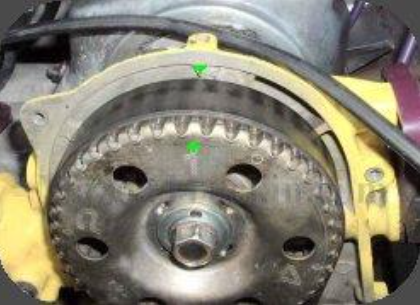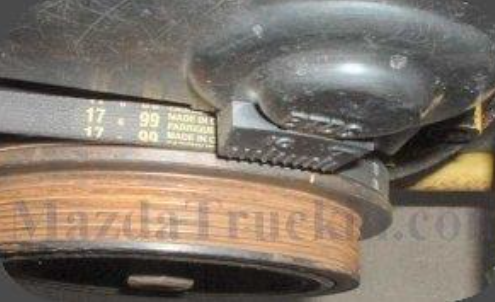Setting a timing belt is one of those amazingly simple things that can be a total nightmare if you’ve never done it before. To put it simply when setting your timing belt you want to make sure the timing mark on your crankshaft, camshaft, and distributor all line up. For an experienced person this may only take a few minutes. Here we will try to step you through the process so you may hopefully get your truck back on the road in a timely manner. If you have already attempted to install you’re timing belt and are uncertain if it is installed properly… read on.
Keep in Mind…
There are some basic things to keep in mind when setting your timing belt. The first thing to remember is that when facing the truck from the front the engine turns clockwise. This is important because the belt is flexible and has lash. Any time we turn the engine while setting the timing we want to turn it only in the clockwise direction, this ensures that you’re timing belt will be tight in the direction of rotation and you won’t have lash to throw off your timing.
When Starting…
Before removing the old timing belt it is good practice to remove the upper timing cover and turn the engine around so that #1 on the cam sprocket is lined up with the pointer above it. Check to make sure that the timing mark on the crank pulley is near the TDC mark on the lower timing cover. If you’re sure the engine was timed right before you started use a white out pen to color the mark on the cam pulley to make it easy to see later.


Removal of the belt
Removing the belt is not difficult, how much you have to remove will depend on how many accessories you have. Remove your clutch fan loosening the (4) 10mm bolts holding it to the pulley. Next remove you’re A/C and power steering belts if you have those followed by your alternator belt. If you are reading this, then it is likely you have never done this before so I recommend removing the upper alternator bracket as well. This will save some frustration by giving you better access to the timing belt later, the bracket is held on with (3) 17mm bolts. You should now have clear access to the front of the engine.
Crank Pulley Removal
If you are reading this page because you are replacing a head gasket or some other repair where the timing belt must be pulled the cam sprocket you can probably skip this step since you don’t have to completely remove the belt. If you are changing the timing belt for a new one, it is recommended that you remove the crank pulley (a.k.a Harmonic Balancer) to make it easier to remove the lower timing cover. The crank pulley is held onto the lower timing gear by (6) 10mm bolts. In the very center of the crank pulley you will find a 21mm bolt, it is NOT necessary to remove this bolt Many people believe this bolt holds the crank pulley to the crank but it does not, if removed this bolt also needs to be torqued to 120 ft/lbs or you will damage the crank. If you do unintentionally remove the bolt reinstall it with an impact gun, it is almost impossible to get it tight any other way.
Finally, Timing Belt Removal
With the crank pulley removed you should be able to remove the 10mm bolts holding the lower timing cover on easily. Once loose the cover should pull right off. To loosen the belt, locate the tensioner pulley, this should be the one closer to the passenger side of the engine and should have a spring attached to it. Loosen it using a 14mm wrench or socket. The tensioner pulley will slide over and starting from the tensioner working clockwise you should now be able to fully remove the belt.
Timing Belt Installation
Now for those famous words you all like to hear. To install the timing sprocket just repeat all of the removal steps in reverse. I can think of a few book authors who should be fired for statements like that, lol!! Ok, now is where a little bit of skill comes into play. Install the belt over the lower timing gear and hold it up through the center of the tensioner and idler pulley. Place you’re lower timing cover back on and tighten down the 10mm bolts which hold it in place. Now remember that timing mark I recommended you paint with the white out marker? Turn the crank around until that lines up with the TDC mark on the lower timing cover perfectly. Now using the 17mm bolt on the cam turn the cam sprocket around until the #1 lines up with the pointer above it.
While using one hand on the left side of the belt to hold tension slowly work the right side around the water pump and idler gear up to the cam sprocket. Pull the belt tight and line it up onto the cam sprocket, work it around to the left but only keep the belt about half way on the cam gear. Now you can route the belt behind the belt tensioner and hold it snug with your left hand on the tensioner. With your right hand push the belt the rest of the way on the cam sprocket and tighten the 14mm bolt on the tensioner. Turn the engine around clockwise few turns to pull the belt tight, loosen the tensioner push it snug and re-tighten it. You should now be ready to check that you installed the belt properly.
Checking Your Work
Remember your math teacher nagging you about checking you’re work in high school? Well here is the practical application, lol. If the belt is not installed properly there is no point in putting everything back together yet. You will just end up frustrated when your truck still doesn’t run and you’ll end up taking it back apart, paying somebody to do it again, or selling your truck. Many members have bought a good truck cheap because a previous owner couldn’t get the engine timed properly and decided to sell it. With the #1 on the cam sprocket pointed up turn the engine around Two full rotations until the timing mark on the crank pulley is exactly on the TDC mark. If the belt was installed properly #1 on the cam sprocket will also be lined up perfectly with the pointer above, it. If #1 on the cam is slightly before or slightly after the pointer, then the timing is off by one tooth.
Finished
Now that you know your belt is timed right you can reinstall the belt tensioner spring if you wish. I usually do not reinstall the spring, it is only there as a precaution in case the 14mm bolt loosens. More than once this spring has come off on one of my engines causing major damage to the timing belt, tensioner, or idler pulley. I would rather remove the upper timing cover once a year and check the bolt. The upper timing cover can go back on and you can reinstall the alternator bracket, belts, fan and any other pieces you removed at the beginning.
Leave a Reply